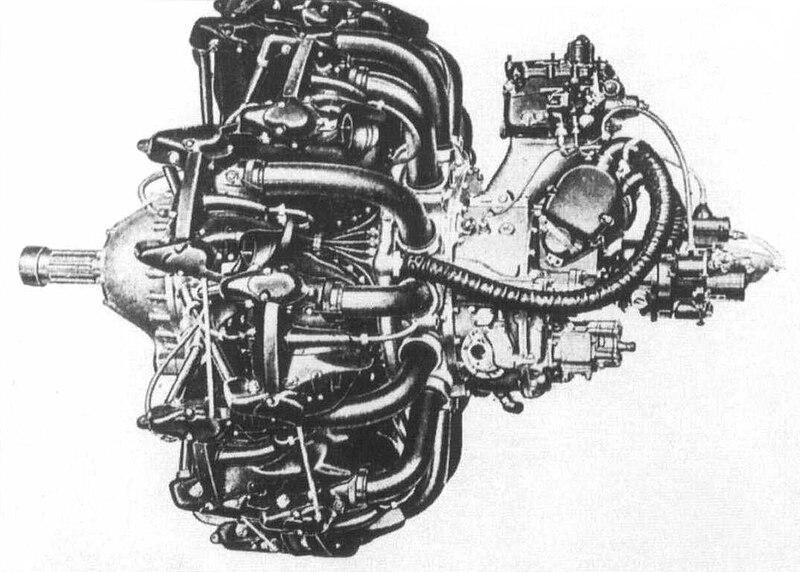
A WARBIRDS RESOURCE
GROUP WEBSITE


Warbird discussion forums
Warbirds-Online
Warbird News and commentary.
Warbird Registry
The histories of individual warbirds.

LUFTWAFFE
U.S.A.A.F
U.S. NAVY
BRITISH
JAPANESE
RUSSIAN
VIETNAM ERA
ALLIED

WHATS NEW
ARTICLES
STAFF
REVIEWS
PX STORE
FAQ
CONTACT US
SUPPORT THE SITE
LINKS
|
|
MAIN INDEX >
Mitsubishi Kasei
The Mitsubishi Kasei Mars was a two-row, 14-cylinder air-cooled radial engine built by Mitsubishi Heavy Industries and used in a variety of World War II Japanese aircraft, such as Mitsubishi J2M and Mitsubishi G4M. It was the largest aircraft engine available in Japan at the start of the war.

Mitsubishi Kasei MK4B 11
Specifications - Kasei MK4V 27
General characteristics
- Bore: 150 millimetres (5.906 in)
- Stroke: 170 millimetres (6.693 in)
- Displacement: 42 L (2,567 cu in)
- Diameter: 1,322 millimetres (52.05 in)
- Dry weight: 780 kilograms (1,719.6 lb)
Components
- Reduction gear: Double planetary spur reduction gear, Ratio: 0.538:1
Performance
- Power output:
-- 1,850 horsepower (1,380 kW) at Takeoff
-- 1,680 horsepower (1,250 kW) at 6,889 feet (2,100 m) Low blower rated with water injection)
-- 1,570 horsepower (1,170 kW) at 18,044 feet (5,500 m), Rated high blower with water injection)
Design/Development
Although originally ordered by Imperial Japanese Navy, the Kasei was based on the earlier Mitsubishi Kinsei engine, itself based originally on a Pratt and Whitney design. Produced in a wide variety of models, the Kasei began with a rated power of 1,530 horsepower (1,140 kW), with a gradual evolution to 1,850 horsepower (1,380 kW) in later wartime versions. Three variants were developed for the Japanese Navy starting in 1939. It was also later adopted by the Imperial Japanese Army as the Ha-32 engine, and was developed further into four variants, including the Ha-111. Production was 8,596 units of all variants.
Physically, the engine had a rather large 1,322 millimetres (52.0 in) diameter compared to the 1,180 millimetres (46.5 in) of the Nakajima Homare engine. Its size and weight meant it was a challenging engine to use on single engine fighters.
Variants
- MK4A 11 - 1,530 horsepower (1,140 kW)
- MK4B 12 - 1,530 horsepower (1,140 kW)
- MK4E 15 - 1,530 horsepower (1,140 kW) - Same power as the MK4A 11 with
improved altitude performance
- MK4V 27 - 1,795 horsepower (1,339 kW)
- MK4R-C 23c - 1,820 horsepower (1,360 kW) - Fitted with a turbo charger that
allowed an output of 1,420 horsepower (1,060 kW) to be maintained up to 30,000 feet
(9,144 m) instead of only 15,750 feet (4,801 m)
- MK4U-4 26a - 1,820 horsepower (1,360 kW)- Mechanically-driven 3-speed
supercharger
- MK4G 25 - 1,825 horsepower (1,361 kW),1,850 horsepower (1,380 kW)
- MK4P 21 - 1,850 horsepower (1,380 kW)
Applications
Sources:
Gunston, Bill. World Encyclopaedia of Aero Engines. Cambridge, England. Patrick Stephens Limited, 1989. ISBN 1-85260-163-9
Jane's Fighting Aircraft of World War II. London. Studio Editions Ltd, 1989. ISBN 0-517-67964-7
Peattie, Mark (2001). Sunburst:The Rise of Japanese Naval Air Power 1909-1941. Naval Institute Press. ISBN 159114664X.
Wikipedia
MAIN INDEX >
|
|
HOW CAN I
SUPPORT
THIS SITE?
(Click Here For Info)
|